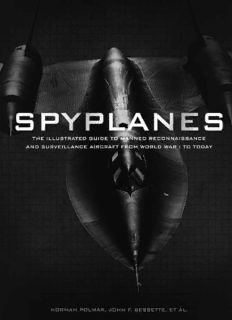
Spyplanes: The Illustrated Guide to Manned Reconnaissance and Surveillance Aircraft from World War I to Today PDF
Preview Spyplanes: The Illustrated Guide to Manned Reconnaissance and Surveillance Aircraft from World War I to Today
SPYPLANES THE ILLUSTRATED GUIDE TO MANNED RECONNAISSANCE AND SURVEILLANCE AIRCRAFT FROM WORLD WAR I TO TODAY BY NORMAN POLMAR AND JOHN F. BESSETTE WITH HAL BRYAN ALAN C. CAREY MICHAEL GORN CORY GRAFF AND NICHOLAS A. VERONICO CONTENTS Perspective PART I Spyplane Operations PART II The Spyplanes Germany Great Britain Russia/Soviet Union United States Endnotes Index PERSPECTIVE To “spy” is to acquire information that another nation—enemy, neutral, and sometimes allied—does not want one to obtain. Spyplanes have been invaluable in obtaining such information for more than a century. And despite the advent of satellites and unmanned aerial vehicles for this role, manned aircraft continue to have great importance as spyplanes. This book is about the development and operations of those aircraft. The terms observation, reconnaissance, and surveillance are closely related, with definitions that differ depending upon the source and perceived function. Observation: Gathering information about the target area from above, primarily using visual means. The term emerged during World War I—especially in the US military—and survived into World War II, when it was largely replaced by “reconnaissance.” Surveillance: Gathering information, but usually when the targets or goals are not well defined. Good examples are maritime surveillance missions, in which aircraft search broad expanses of ocean seeking possible shipping or naval activity. Austrian guards on the Galician border take aim at Russian aviators making reconnaissance flights in aircraft fitted with electric searchlights. The military potential of aerial observation had been noted as far back as the eighteenth century, but it saw its first true expression with fixed-wing aircraft in World War I. Private Collection/© Look and Learn/Bridgeman Images Reconnaissance: Similarly gathering information, but increasingly using more technical means, such as photographic, electronic, and communications intercept systems as well as visual sightings. Usually reconnaissance missions have specific targets or at least specific goals in mind (that is, to determine the frequencies of a specific radar set). Within “reconnaissance,” there are two broad types of missions—tactical and strategic: Tactical reconnaissance involves operations in the vicinity of, or in direct support of, ongoing or impending battles. Strategic reconnaissance covers all other aspects of information gathering in this context, for example, monitoring borders of hostile or potentially hostile entities during times of tension, or gathering information on political, economic, and military aspects away from the battlefield. Determining which aircraft to include in this volume became an exercise in deciding which aircraft to exclude. In the broad sense, virtually all military and many civilian aircraft have had a role in “aerial spying” at some time in some place. From the very beginning of armed flight, nations have asked (or ordered) their aircrews—whether on combat missions such as fighter escorts or nuclear strikes, or airlift large and small—to report their observations of the enemy to an intelligence officer. Thus, all aircraft are in some sense “spyplanes.” Some spyplanes are covert—innocent-appearing transport aircraft, commercial/civil or military—with hidden electronic surveillance gear. These include Sydney Cotton flying covert photo missions in a Lockheed 12A over Germany in the 1930s on behalf of the British government, and US Air Force C- 97G Stratofreighters flown over East Germany during the Cold War. Most spyplanes are overt, like the high-flying, highly publicized US U-2 and SR-71, or the lumbering, graceful Soviet/Russian Bear. A major issue when describing spyplanes is the “cut” between tactical and strategic aircraft. An aircraft such as the LTV RF-8 Crusader was primarily a tactical recon aircraft, but during the Cuban missile crisis of 1962, the RF-8s from Navy light photograph squadron VFP-62 were employed to obtain strategic-level intelligence of Soviet missile emplacements. Similarly, the Lockheed RF-80 Shooting Star, another tactical recon aircraft, flew strategic missions into Manchuria to ascertain the status of Chinese and Soviet airfields during the 1950–1953 Korean conflict. Thus, the lines between tactical and strategic spyplanes often become blurred. We have decided to address both types of “spyplanes,” in part because of this overlap in missions and assignments. The officially recognized American short term for reconnaissance is “recon,” which is used in this book, while the British tend to use the term “recce.” ABBREVIATIONS AAF Army Air Forces (US, 1941–1948) AFB Air Force Base AWS Air Weather Service (US) ASW anti-submarine warfare CIA Central Intelligence Agency (US) COMINT communications intelligence CV aircraft carrier CVA attack aircraft carrier CVAN attack aircraft carrier (nuclear-propelled) CVS anti-submarine aircraft carrier ECM electronic countermeasures ELINT electronic intelligence FEAF Far East Air Forces (US) FLIR forward-looking infrared HASP high-altitude sampling program JCS Joint Chiefs of Staff LPH amphibious assault ship Mach speed of sound (named for Ernst Mach) MAD magnetic anomaly detection NATO North Atlantic Treaty Organization PACAF Pacific Air Forces (US) PARPRO Peacetime Aerial Reconnaissance Program (US) RAF Royal Air Force (UK) RPA remotely piloted aircraft SA-( ) Soviet surface-to-air missile (NATO designation) SAC Strategic Air Command (AAF command, 1946–1947; USAF/US Specified Command, 1947–1992) SENSINT sensitive intelligence SIGINT signals intelligence (includes COMINT and ELINT) SLAR side-looking aircraft radar TV television unmanned aerial vehicle unmanned aerial vehicle UAV USAF US Air Force (1948–) USAFE US Air Forces Europe USN US Navy VFP light photographic squadron (US Navy) VQ fleet air reconnaissance squadron (US Navy)
Description: